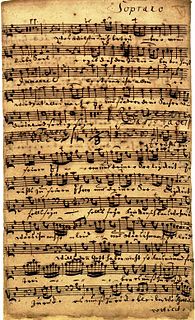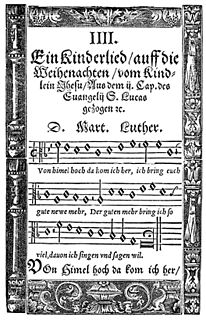Dactylic hexameter is a form of meter or rhythmic scheme in poetry. It is traditionally associated with the quantitative meter of classical epic poetry in both Greek and Latin and was consequently considered to be the grand style of Western classical poetry. Some premier examples of its use are Homer's Iliad and Odyssey, Virgil's Aeneid, and Ovid's Metamorphoses. Hexameters also form part of elegiac poetry in both languages, the elegiac couplet being a dactylic hexameter line paired with a dactylic pentameter line.
In poetry, a hendecasyllable is a line of eleven syllables. The term "hendecasyllabic" is used to refer to two different poetic meters, the older of which is quantitative and used chiefly in classical poetry and the newer of which is accentual and used in medieval and modern poetry. It is often referred to when an iambic parameter contains 11 syllables.
Hexameter is a metrical line of verses consisting of six feet. It was the standard epic metre in classical Greek and Latin literature, such as in the Iliad, Odyssey and Aeneid. Its use in other genres of composition include Horace's satires, Ovid's Metamorphoses, and the Hymns of Orpheus. According to Greek mythology, hexameter was invented by Phemonoe, daughter of Apollo and the first Pythia of Delphi.
In poetry, metre (British) or meter is the basic rhythmic structure of a verse or lines in verse. Many traditional verse forms prescribe a specific verse metre, or a certain set of metres alternating in a particular order. The study and the actual use of metres and forms of versification are both known as prosody.

Humpty Dumpty is a character in an English nursery rhyme, probably originally a riddle and one of the best known in the English-speaking world. He is typically portrayed as an anthropomorphic egg, though he is not explicitly described as such. The first recorded versions of the rhyme date from late eighteenth-century England and the tune from 1870 in James William Elliott's National Nursery Rhymes and Nursery Songs. Its origins are obscure, and several theories have been advanced to suggest original meanings.
The Sapphic stanza, named after Sappho, is an Aeolic verse form spanning four lines.
The double dactyl is a verse form invented by Anthony Hecht and Paul Pascal in 1951.

The Rape of Lucrece (1594) is a narrative poem by William Shakespeare about the legendary Roman noblewoman Lucretia. In his previous narrative poem, Venus and Adonis (1593), Shakespeare had included a dedicatory letter to his patron, the Earl of Southampton, in which he promised to compose a "graver labour". Accordingly, The Rape of Lucrece has a serious tone throughout.

A dactyl is a foot in poetic meter. In quantitative verse, often used in Greek or Latin, a dactyl is a long syllable followed by two short syllables, as determined by syllable weight. In accentual verse, often used in English, it is a stressed syllable followed by two unstressed syllables—the opposite is the anapaest.
A McWhirtle is a light verse form similar to a double dactyl, invented in 1989 by American poet Bruce Newling. McWhirtles share essentially the same form as double dactyls, but without the strict requirements, making them easier to write. Specifically:
Iambic pentameter is a type of metric line used in traditional English poetry and verse drama. The term describes the rhythm, or meter, established by the words in that line; rhythm is measured in small groups of syllables called "feet". "Iambic" refers to the type of foot used, here the iamb, which in English indicates an unstressed syllable followed by a stressed syllable. "Pentameter" indicates a line of five "feet".
A catalectic line is a metrically incomplete line of verse, lacking a syllable at the end or ending with an incomplete foot. One form of catalexis is headlessness, where the unstressed syllable is dropped from the beginning of the line.
This is a glossary of poetry.
The following outline is provided as an overview of and introduction to poetry:
Aeolic verse is a classification of Ancient Greek lyric poetry referring to the distinct verse forms characteristic of the two great poets of Archaic Lesbos, Sappho and Alcaeus, who composed in their native Aeolic dialect. These verse forms were taken up and developed by later Greek and Roman poets and some modern European poets.

Johann Sebastian Bach composed the church cantata Was willst du dich betrüben, BWV 107 in Leipzig for the seventh Sunday after Trinity and first performed on 23 July 1724. The chorale cantata is based on the words of Johann Heermann's hymn in seven stanzas "Was willst du dich betrüben" (1630).

Humpty Sharma Ki Dulhania is a 2014 Indian Hindi-language romantic comedy film written and directed by Shashank Khaitan in his directorial debut, and produced by Karan Johar under the banner of Dharma Productions. It features Varun Dhawan as Humpty Sharma, Alia Bhatt as Kavya Pratap Singh and Sidharth Shukla as Angad Humpty Sharma Ki Dulhania notes the second pairing of leads after their debut Student of the Year and was released on 11 July 2014 and emerged a commercial success. A sequel, Badrinath Ki Dulhania, was released in 2017.

Spring is a lyric poem written and illustrated by William Blake. It was first published in Songs of Innocence (1789) and later in Songs of Innocence and Experience (1794).

"Vom Himmel hoch, da komm ich her" is a hymn text relating to the Nativity of Jesus, written by Martin Luther in 1534. The hymn is most often sung to a melody that first appeared in 1539 and that was likely composed by Luther as well. That version became a classic Christmas carol, and many composers referred to it in their compositions.